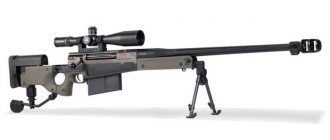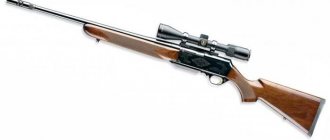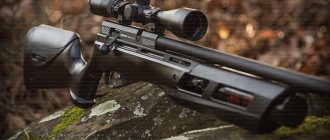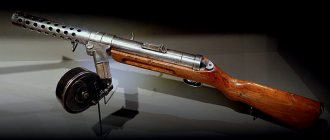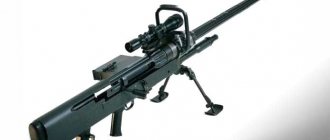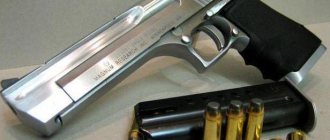The Kalashnikov assault rifle, one of the first and most successful examples of its class.
Automatic carbine, a weapon of a similar class made in the USA. This term has other meanings, see Automatic.
See also: Automatic rifle
Machine
[1], in foreign literature also
an assault rifle
(English assault rifle) is a hand-held individual automatic firearm designed to defeat enemy personnel in close combat and capable of creating a high density of fire.
Automatic rifles became widespread in the USSR in the years after World War II, replacing as the main infantry weapon simultaneously: a submachine gun, a repeating non-automatic rifle, as well as various types of self-loading and automatic rifles and carbines of the previous generation.
This term is used mainly in Russia and the countries of the former USSR. Abroad, weapons of similar class are usually called automatic carbines or rifles, depending on the length of the barrel.
The characteristic features of the machine are: the use of an intermediate (intermediate low-pulse ones are currently common) or rifle cartridge[2]; the presence of a replaceable high-capacity magazine[3]; relative compactness and lightness (barrel length no more than 600 mm, weight about 3-4 kg without cartridges); the presence of a burst firing mode, considered, as a rule, as the main type of firing from a weapon of this type.
7.62 mm Kalashnikov assault rifle (AK) (USSR)
7.62 mm Kalashnikov assault rifle (AK) - an assault rifle adopted by the USSR in 1949; GRAU index - 56-A-212. It was designed in 1947 by Mikhail Timofeevich Kalashnikov.
AK and its modifications are the most common small arms in the world. According to available estimates, up to 1/5 of all small firearms on Earth belong to this type (including licensed and unlicensed copies, as well as third-party developments based on AK). Over 60 years, more than 70 million Kalashnikov assault rifles of various modifications were produced. They are in service with 50 foreign armies. The main competitor of the Kalashnikov assault rifles, the American M16 automatic rifle, was produced in quantities of approximately 10 million units and is in service with 27 armies around the world. According to many experts, the Kalashnikov assault rifle is the standard of reliability and ease of maintenance.
Based on the 7.62-mm Kalashnikov assault rifle, a family of military and civilian small arms of various calibers was created, including AKM and AK74 assault rifles and their modifications, a Kalashnikov light machine gun, carbines and smooth-bore guns "Saiga" and others, including abroad in the USSR.
Heckler und Koch G11 (Germany)
The development of the G11 rifle was started by Heckler and Koch (Germany) at the very end of the 1960s, when the German government decided to create a new, more effective rifle to replace the G3 rifles.
Based on the results of the research, it was decided that the Bundeswehr needed a light, small-caliber rifle with high shooting accuracy. To ensure reliable destruction of the enemy, it was necessary to ensure that several bullets hit the target, so it was decided to create a rifle chambered for a caseless cartridge of 4.3mm caliber (later moved to 4.7mm caliber) with the ability to fire in single, long bursts and with a burst cut-off of 3 shots . The Heckler-Koch company was supposed to create such a rifle, with the participation of the Dynamite-Nobel company, responsible for the development of a new caseless cartridge.
Sturmgewehr - Haenel / Schmeisser MP 43MP 44 Stg.44 (Germany)
The development of hand-held automatic weapons chambered for a cartridge intermediate in power between pistol and rifle began in Germany even before the outbreak of World War II, in the mid-thirties. In 1939, the intermediate cartridge 7.92×33 mm (7.92mm Kurz), developed on the initiative of the German company Polte, was chosen as the new basic ammunition. In 1942, by order of the German arms department HWaA, two companies began developing weapons for this cartridge - CG Haenel and Karl Walther. In general, the Stg.44 assault rifle was a relatively successful model, providing effective fire with single shots at a range of up to 500-600 meters and automatic fire at a range of up to 300 meters, although it was, however, overly heavy and not very convenient to use, especially when shooting lying down.
There is a common legend that the Kalashnikov assault rifle was copied from the Sturmgewehr and that Schmeisser himself, allegedly, while in Soviet captivity, participated in the development of the AK. HOWEVER, it is impossible to talk about Kalashnikov’s DIRECT BORROWING from the Schmeisser design - the AK and Stg.44 designs contain too many fundamentally different solutions (receiver layout, trigger device, barrel locking unit, etc.). And the very possible participation of Schmeiser in the development of the Kalashnikov assault rifle looks more than doubtful, given that the myth places Hugo Schmeiser in Izhevsk, while the experimental AK-47 was created in Kovrov.
G11 design.
The rifle's automation operates using the energy of powder gases removed from the barrel. The cartridges are placed in the magazine above the barrel with the bullets facing down. The G11 rifle has a unique rotating breech chamber into which the cartridge is fed vertically downward before firing. Then, the chamber rotates 90 degrees, and when the cartridge aligns with the barrel line, a shot occurs, but the cartridge itself is not fed into the barrel. Since the cartridge is caseless (with a combustible primer), the automatic operation cycle is simplified by eliminating the extraction of the spent cartridge case. In the event of a misfire, the faulty cartridge is pushed down when the next cartridge is fed. The mechanism is cocked using a rotary handle on the left side of the weapon. When shooting, this handle remains motionless.
The barrel, firing mechanism (excluding safety/translator and trigger), rotating breech with mechanics and magazine are mounted on a single base that can move back and forth inside the rifle body. When firing in single or long bursts, the entire mechanism performs a full recoil-recoil cycle after each shot, which ensures reduced recoil (similar to artillery systems). When firing in bursts of three shots, the cartridge is fed and fired immediately after the previous one, at a rate of up to 2000 rounds per minute. In this case, the entire mobile system comes to the extremely rear position already AFTER the third shot, while the recoil begins to affect the weapon and the shooter again after the end of the burst, which ensures extremely high accuracy of fire (a similar solution was used in the Russian AN-94 “Abakan” assault rifle ).
